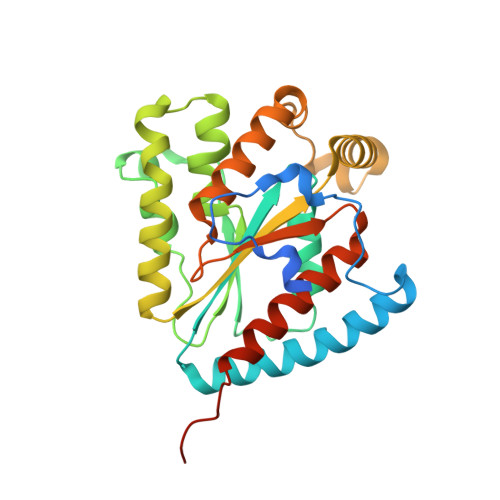Substrate recognition and mechanism revealed by ligand-bound polyphosphate kinase 2 structures.
Parnell, A.E., Mordhorst, S., Kemper, F., Giurrandino, M., Prince, J.P., Schwarzer, N.J., Hofer, A., Wohlwend, D., Jessen, H.J., Gerhardt, S., Einsle, O., Oyston, P.C.F., Andexer, J.N., Roach, P.L.(2018) Proc Natl Acad Sci U S A 115: 3350-3355
- PubMed: 29531036
- DOI: https://doi.org/10.1073/pnas.1710741115
- Primary Citation of Related Structures:
5LC9, 5LCD, 5LD1, 5LDB, 5LL0, 5LLB, 5LLF, 5MAQ, 5O6K, 5O6M - PubMed Abstract:
Inorganic polyphosphate is a ubiquitous, linear biopolymer built of up to thousands of phosphate residues that are linked by energy-rich phosphoanhydride bonds. Polyphosphate kinases of the family 2 (PPK2) use polyphosphate to catalyze the reversible phosphorylation of nucleotide phosphates and are highly relevant as targets for new pharmaceutical compounds and as biocatalysts for cofactor regeneration. PPK2s can be classified based on their preference for nucleoside mono- or diphosphates or both. The detailed mechanism of PPK2s and the molecular basis for their substrate preference is unclear, which is mainly due to the lack of high-resolution structures with substrates or substrate analogs. Here, we report the structural analysis and comparison of a class I PPK2 (ADP-phosphorylating) and a class III PPK2 (AMP- and ADP-phosphorylating), both complexed with polyphosphate and/or nucleotide substrates. Together with complementary biochemical analyses, these define the molecular basis of nucleotide specificity and are consistent with a Mg 2+ catalyzed in-line phosphoryl transfer mechanism. This mechanistic insight will guide the development of PPK2 inhibitors as potential antibacterials or genetically modified PPK2s that phosphorylate alternative substrates.
Organizational Affiliation:
Chemistry, University of Southampton, Southampton, Hampshire SO17 1BJ, United Kingdom.

















